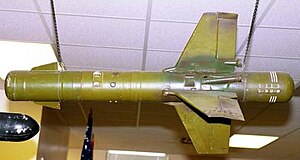AT-2 Swatter
| 3M11 / 9M17 AT-2 Swatter |
|
|---|---|

AT-2C Swatter
|
|
| Type | Anti-tank missile |
| Place of origin |
|
| Service history | |
| In service | 1964-present |
| Production history | |
| Designer | Nudelman OKB-16 |
| Specifications | |
| Weight | 27 kilograms (60 lb) |
| Length | 116 cm (46 in) |
| Diameter | 148 mm (5.8 in) |
| Warhead | HEAT |
| Warhead weight | 5.4 kg (12 lb) |
|
|
|
| Engine | Solid fuel rocket |
| Wingspan | 68 cm (27 in) |
|
Operational
range |
0.5 to 2.5 kilometres (0.31 to 1.55 mi) |
| Speed | 160 m/s (360 mph) |
|
Guidance
system |
Radio command |
|
Steering
system |
MCLOS |
|
Launch
platform |
Mi-4, Mi-8, Mi-24, Mi-25, BRDM-1, BRDM-2 |
The AT-2 Swatter is the NATO reporting name for the 3M11 Fleyta (flute) MCLOS radio command Anti-tank missile of the Soviet Union.
The missile was developed by the Nudelman OKB-16 design bureau. It was developed at about the same time as the AT-1 Snapper as a heavy ATGM for use on both ground launchers and helicopters. It addressed some of the problems of the AT-1; it was much faster, and had slightly longer range. These improvements were achieved by sending commands via a radio link instead of a trailing guidance wire - which allowed the missile to travel faster. However, it did make it vulnerable to jamming. The missile system was shown to Soviet premier Nikita Khrushchev in September 1964, and accepted for service shortly afterwards.
The AT-2 was the first Soviet ATGM to be deployed from helicopters. Small numbers where fitted to the Mi-4AV. The missile was deployed on the Mi-8 Hip as well as the Mi-24, and Mi-25 `Hind' series of helicopters. It was also deployed on the BRDM-1 and BRDM-2 infantry fighting vehicles.
The original AT-2A (3M11 Falanga) missile was problematic - one Russian source describes the missile as "notable for its complexity and low reliability". Also, the missile's range was felt to be inadequate. An improved version of the missile was developed: the AT-2B (9M17 Skorpion). Externally, the missiles are very similar; however, the AT-2B range is increased to 3.5 km. The standard production version was the 9M17M Skorpion-M, which entered service in 1968.
The next development was to integrate SACLOS guidance - the result was the AT-2 Swatter-C or 9M17P Skorpion-P. It entered service in 1969. A product improved version the 9M17MP was developed that had an improved engine and signal lamp.
...
Wikipedia
